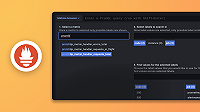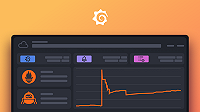Important: This documentation is about an older version. It's relevant only to the release noted, many of the features and functions have been updated or replaced. Please view the current version.
Prometheus template variables
Instead of hard-coding details such as server, application, and sensor names in metric queries, you can use variables. Grafana refers to such variables as template variables. Grafana lists these variables in dropdown select boxes at the top of the dashboard to help you change the data displayed in your dashboard.
For an introduction to templating and template variables, see Templating and Add and manage variables.
Use query variables
You have the option to use several different variable types, but variables of the type Query will query Prometheus for a list of metrics, labels, label values, a query result or a series.
Select a Prometheus data source query type and enter the required inputs:
For details on metric names, label names, and label values, refer to the Prometheus documentation.
Query options
Under the query variable type, you can set the following query options:
Selection options
The following selection options are available:
Multi-value - Check this option to enable multiple values to be selected at the same time.
Include All option - Check this option to include all variables.
Use interval and range variables
You can use some global built-in variables in query variables, for example, $__interval, $__interval_ms, $__range, $__range_s and $__range_ms.
For details, see Global built-in variables.
The label_values function doesn’t support queries, so you can use these variables in conjunction with the query_result function to filter variable queries.
Make sure to set the variable’s refresh trigger to be On Time Range Change to get the correct instances when changing the time range on the dashboard.
Example:
Populate a variable with the busiest 5 request instances based on average QPS over the time range shown in the dashboard:
Query: query_result(topk(5, sum(rate(http_requests_total[$__range])) by (instance)))
Regex: /"([^"]+)"/Populate a variable with the instances having a certain state over the time range shown in the dashboard, using $__range_s:
Query: query_result(max_over_time(<metric>[${__range_s}s]) != <state>)
Regex:Use $__rate_interval
Note
Available in Grafana v7.2 and higher.
We recommend using $__rate_interval in the rate and increase functions instead of $__interval or a fixed interval value.
Because $__rate_interval is always at least four times the value of the Scrape interval, it avoid problems specific to Prometheus.
For example, instead of using:
rate(http_requests_total[5m])or:
rate(http_requests_total[$__interval])We recommend that you use:
rate(http_requests_total[$__rate_interval])The value of $__rate_interval is defined as
max($__interval + Scrape interval, 4 * Scrape interval),
where Scrape interval is the “Min step” setting (also known as query*interval, a setting per PromQL query) if any is set.
Otherwise, Grafana uses the Prometheus data source’s “Scrape interval” setting.
The “Min interval” setting in the panel is modified by the resolution setting, and therefore doesn’t have any effect on Scrape interval.
For details, refer to the Grafana blog.
Choose a variable syntax
The Prometheus data source supports two variable syntaxes for use in the Query field:
$<varname>, for examplerate(http_requests_total{job=~"$job"}[$_rate_interval]), which is easier to read and write but does not allow you to use a variable in the middle of a word.[[varname]], for examplerate(http_requests_total{job=~"[[job]]"}[$_rate_interval])
If you’ve enabled the Multi-value or Include all value options, Grafana converts the labels from plain text to a regex-compatible string, which requires you to use =~ instead of =.
Use the ad hoc filters variable type
Prometheus supports the special ad hoc filters variable type, which you can use to specify any number of label/value filters on the fly. These filters are automatically applied to all your Prometheus queries.


